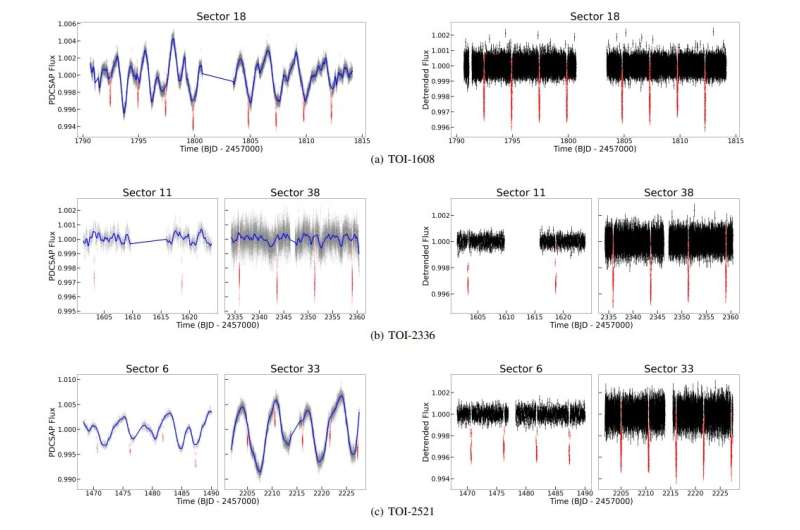November 3, 2022 report
Two low-mass stars and one brown dwarf discovered around aged stars

Using the Transiting Exoplanet Survey Satellite (TESS), an international team of astronomers has detected three companions to aged stars—two low-mass stars and one brown dwarf. The newfound objects are the size of Jupiter but at least 70 times more massive than the solar system's biggest planet. The finding is reported in a paper published October 25 on the arXiv pre-print server.
TESS is conducting a survey of about 200,000 of the brightest stars near the sun with the aim of searching for transiting exoplanets. So far, it has identified nearly 6,000 candidate exoplanets (TESS Objects of Interest, or TOI), of which 266 have been confirmed so far. Besides extrasolar planets, TESS helped astronomers to detect numerous brown dwarfs and companion stars.
Now, a group of astronomers led by Zitao Lin of the Tsinghua University in Beijing, China, reports the detection of transit signals around three aged F-type and G-type subgiant stars designated TOI-2336, TOI-1608 and TOI-2521. Follow-up observations using ground-based observatories indicated that these signals are not caused by exoplanets but by much more massive objects.
"In this paper, we confirmed one brown dwarf, TOI-2336 b, and two objects near the hydrogen burning mass limit, TOI-1608 b and TOI-2521 b, transiting three aged stars," the researchers wrote.
TOI-2336 b has a radius of 1.05 Jupiter radii and its mass was found to be nearly 70 Jupiter masses, which yields a density at a level of 75 g/cm3. Taking into account its mass, the object was classified as a brown dwarf. TOI-2336 b orbits its host every 7.71 days at a distance of some 0.08 AU from it.
TOI-1608 b is about 21 percent larger and at least 90 times more massive than Jupiter, therefore its density was calculated to be 63.7 g/cm3. According to the study, the object is separated from TOI-1608 by 0.04 AU and its orbital period is approximately 59 hours. The properties of TOI-1608 b suggest that it is most likely a low-mass M dwarf star.
When it comes to TOI-2521 b, it was found that the object is the size of Jupiter and about 77.5 times more massive than the solar system's biggest planet. These results yield a density at a level of nearly 93 g/cm3. TOI-2521 b is also assumed to be a low-mass M dwarf, with an orbital period of 5.56 days and a distance to the primary star of some 0.06 AU.
Summing up the results, the researchers underlined that all the three newfound objects are inflated.
"We found that all three companions have inflated radii via comparison to the evolution models for brown dwarfs and low mass stars," the authors of the paper concluded.
More information: Zitao Lin et al, Three low-mass companions around aged stars discovered by TESS, arXiv (2022). DOI: 10.48550/arxiv.2210.13939
Journal information: arXiv
© 2022 Science X Network





















